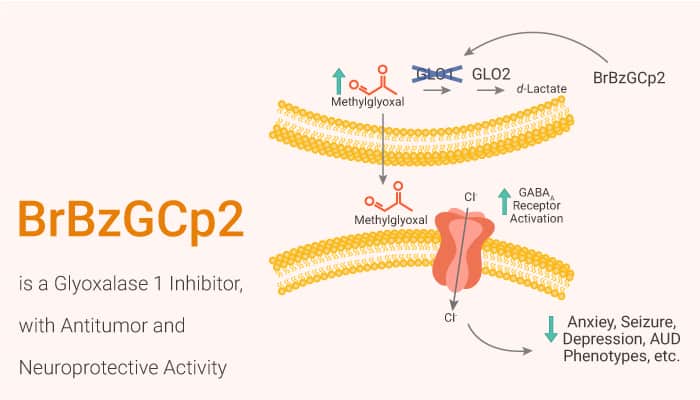The glyoxalase system is a ubiquitous enzymatic network that plays important role in biological life. The glyoxalase system consists of glyoxalase 1 (GLO1), glyoxalase 2 (GLO2), and reduced glutathione (GSH). They perform an essential metabolic function in cells by detoxifying methylglyoxal (MG). GLO performs an essential metabolic function by detoxifying MG into d-lactate.
Glyoxalase 1 (GLO1) is a ubiquitous cellular enzyme. GLO1 participates in the detoxification of methylglyoxal (MG). MG is a cytotoxic byproduct of glycolysis that induces protein modification, oxidative stress, and apoptosis. In particular, GLO1 and MG implicate in the pathogenesis of diabetic complications. BrBzGCp2 is a glyoxalase 1 (GLO1) inhibitor, with antitumor and neuroprotective activity.

MG levels rise under high-glucose conditions, such as diabetes. In vitro, overexpression of Glo1 prevents MG accumulation; conversely, GLO1 inhibition increases MG accumulation and decreased cellular viability. GLO1 inhibition by BrBzGCp2 increases methylglyoxal (MG) concentration and reduced anxiety-like behavior in mice. Similarly, BrBzGCp2 attenuates epileptic seizures in mice. GLO1 inhibition reduces anxiety-like behavior.
Finally, researchers evaluated the suitability of GLO1 as a target for anxiolytic drugs by synthesizing BrBzGCp2, a previously described GLO1 inhibitor. Moreover, they confirmed that BrBzGCp2 inhibited GLO1 enzymatic activity in vitro. They then administered BrBzGCp2 (30 mg/kg) by i.p. injection to WT B6 mice and allowed MG levels to accumulate for 2 hours. GLO1 inhibition by BrBzGCp2 increased center time in the OF test, without changing the distance traveled. GLO1 inhibition increases MG concentration, thus reducing anxiety-like behavior. We obtained similar results in CD-1 mice treated with BrBzGCp2.
All in all, BrBzGCp2 is a GLO1 inhibitor. Pre-treatment with BrBzGCp2 decreases seizure duration.